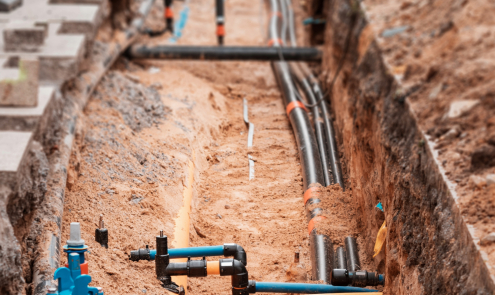THE ROAD TO NET ZERO CARBON
02 Sep 2021
It was only a matter of weeks ago that the Intergovernmental Panel on Climate Change (IPCC) published a global climate change report which proclaimed a ‘code red for humanity’. The report gained traction at a time where wildfires were tearing through Greece and Turkey, with parts of western Germany recovering from the most serious floods in years. With the spotlight on global industries to reduce greenhouse gas emissions and hit net zero targets, which pathways can the construction industry pursue to stop climate change in its tracks?
By Ellen Huelin, Associate Director at Whitecode
It was only a matter of weeks ago that the Intergovernmental Panel on Climate Change (IPCC) published a global climate change report which proclaimed a ‘code red for humanity’. The report gained traction at a time where wildfires were tearing through Greece and Turkey, with parts of western Germany recovering from the most serious floods in years. With the spotlight on global industries to reduce greenhouse gas emissions and hit net zero targets, which pathways can the construction industry pursue to stop climate change in its tracks?
A few months ago, the new London Plan was published by the GLA (Greater London Authority). As well as providing a general framework for the capital’s development, the plan drew attention to the reduction of carbon emissions. The plan has centred on net zero targets and has made it known that environmental considerations must be integrated into a construction plan or programme.
Previously, the London Plan focused mainly on the reduction of carbon emissions, using SAP and SBEM as the methodology of calculation. These are well established processes which have been used for Building Regulations compliance for many years. Both focus on regulated energy, as does the London Plan, which requires onsite carbon reduction of a minimum of 35%. Although unregulated carbon, from plug in equipment using electricity, is estimated and reported in the London Plan, there is no requirement to reduce this in the same way as regulated carbon.
The ‘Be Seen’ level of the energy hierarchy will require an estimation of operational energy for developments, with the aim of reducing the performance gap. This will need to be submitted at planning application stage and will be monitored for the first five years through the GLA portal. The use of CIBSE TM54 assessments alongside SAP and SBEM is a step further to address overall carbon and energy reduction during building operation.
Rise of embodied carbon
Embodied carbon is an intrinsic part of the new London Plan. The GLA currently has benchmarks to report against, but over the next few years it is likely we will see targets set for embodied carbon. Although lifecycle assessment of materials has been a component of BREEAM assessments since 2018, seeing it as part of the London Plan means that embodied carbon must be considered in all new developments in London, which is welcome news given the UK’s net zero carbon ambitions.
It is encouraging to see additional attention is being paid to embodied carbon. We have to take a holistic approach to meet net zero targets and reduce the damaging effects of climate change, as opposed to focusing on a single piece of the puzzle. From very early on in a project, it is now a GLA requirement to provide a clear strategy and report regarding this aspect. Doing so will fulfil the application criteria.
A closer look
Whole lifecycle carbon reports will, then, encourage developers to interrogate their choices and specifications at a pre-planning stage. The embodied carbon content of a building material will be analysed for its impact from cradle-to-grave. Key questions will be asked in terms of where the materials originate from and whether they are the most sustainably sourced.
If we take concrete as an example – a key contributor to the embodied carbon footprint of most buildings and infrastructure assets – there may be questions as to how much concrete is going to be used, the percentage of sustainable content and whether there is the potential to reduce its application.
Furthermore, the GLA requires the area of photovoltaic (PV) panels on the roof to be maximised at planning stage. The carbon factor associated with electricity has significantly reduced in recent years due to the decarbonisation of the grid, which means the carbon saving from PV panels has also lowered. Despite this PV panels are still a key part of contributing to the decarbonisation we are trying to achieve. Now we are considering embodied carbon of building elements in the whole lifecycle carbon assessment, the embodied carbon associated with the majority of PV panels is very high. Traditionally, this would have been offset by the high carbon saving provided by the PV panels. As the carbon saving reduces with the decarbonisation of the grid, the embodied carbon becomes more important.
There is no doubt that the use of PV panels is important in the journey towards net zero carbon. However, the high embodied carbon associated with the production will need to be addressed to reduce the whole lifecycle carbon impact. There is also a lack of embodied carbon data and Environmental Product Declarations (EPDs) available for PV panels.
In the meantime, developers can take their own steps through completing whole lifecycle carbon reports and truly committing to products with lower embodied carbon. Consultants are able to give a variety of options to see which sustainable materials fit a development best, but until developers are willing to make significant changes in their procurement and supply chain, the impact will not be seen. It is hoped that completing whole lifecycle carbon assessments will improve awareness of the provenance of materials and how they impact on the overall carbon emissions throughout the lifecycle of a building.
The London Plan’s decision to centre carbon targets is a key decision given the ongoing effects of climate change. Embodied carbon will continue to take a priority as time unfolds, with specific targets sure to be on the horizon. In terms of our planet’s health, it is certainly a move in the right direction.

WHITECODE CONSULTING GAINS HIGHLY...
As a company that prides itself on sustainability in design and exceeding – not just meeting – industry standards, Whitecode Consulting is delighted to announce it has gained the coveted Chartered Institution of Building Services...
Read More
Utilities consultants: helping to prevent...
Utilities consultants: providing the vital support every construction project needs
By Gary Akers, Head of Utilities at Whitecode Consulting
The UK’s cost of living crisis is adding significant financial challenges for everyone...
Read MoreLike to Know More? Let's Talk...







